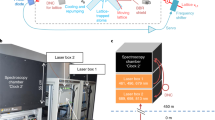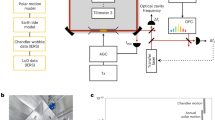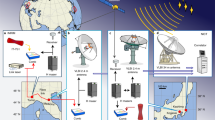Abstract
WHEN baseline lengths approach the diameter of the Earth, relativistic effects become important, especially in geodetic applications. Failure to take account of these effects results in errors that are equivalent to clock errors of the order of a few parts in 1012.
This is a preview of subscription content, access via your institution
Access options
Subscribe to this journal
Receive 51 print issues and online access
$199.00 per year
only $3.90 per issue
Buy this article
- Purchase on Springer Link
- Instant access to full article PDF
Prices may be subject to local taxes which are calculated during checkout
Similar content being viewed by others
References
Riedel, O., Nuovo cim., 25, 237 (1962).
Pauli, W., Theory of Relativity, 19 (Pergamon, Oxford, 1958).
Author information
Authors and Affiliations
Rights and permissions
About this article
Cite this article
ROBERTSON, D. Special relativity and very long baseline interferometers. Nature 257, 467–468 (1975). https://doi.org/10.1038/257467a0
Received:
Accepted:
Issue Date:
DOI: https://doi.org/10.1038/257467a0
This article is cited by
-
The quasi-Doppler experiment according to absolute space-time theory
Foundations of Physics (1981)
Comments
By submitting a comment you agree to abide by our Terms and Community Guidelines. If you find something abusive or that does not comply with our terms or guidelines please flag it as inappropriate.



